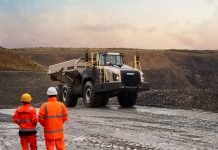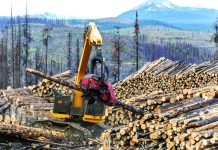
When it coming to illuminating a jobsite, LED lights are becoming a viable option, according to Todd Howe, from Doosan Portable Power.
While metal halide bulbs have served as the standard in jobsite lighting, LED is catching up in terms of cost and light output.
“This is one of those areas that’s moving pretty fast,” Howe said. “It’s about fuel efficiency in our world and it’s about runtime.”
A light tower equipped with LED lights will generally run for at least twice as long as a conventional setup using the same amount of power.
“It’s very efficient lighting. They consume less energy but produce a comparable amount of light,” Howe said.
While the actual lumens produced by an LED lights have yet to reach par with metal halide, the technology is constantly improving.
“The guy using it for his work purpose doesn’t notice a discernible difference anymore,” Howe said.
Alongside lower power consumption, the price of LED is also dropping.
While the lights are about twice the price of metal halide, Howe believes the cost will level out within 18 months.
“The price of the fixtures has been high up to this point,” he said. “Now the pricing is starting to come down, I wouldn’t say to parity, but to a place where it pencils out as an attractive business case.”
Offsetting the current higher cost is the fact that LEDs do not require replacement bulbs. While metal halide bulbs have a long-lifespan, the rough environment of construction sites, as well as transporting the light towers, may lead to an early demise.
RELATED: Caterpillar enters the UTV market
“The LED lifespan is 50,000 hours and there’s no maintenance,” Howe said. “It’s well past the life of the rest of the machine frankly.”
The lights also feature the ability to instantly turn them on and off without waiting.
“With metal halide, you have to wait before restarting the light,” Howe said.
At Doosan Portable Power, LED is available on the LSC light tower. The 1,800-rpm water-cooled diesel engine meets EPA Tier 4-Final emission regulations.
The power rating of the LSC is 6 kilowatts with the utilization of a high output alternator. This voltage allows operators to illuminate the unit’s four 1,000-watt metal halide floodlights or LED lamps and utilize the receptacle power function simultaneously.
With the Kubota engine, the LSC has an extended service interval of 750 hours making it the highest in the industry to work longer without interruption for service, according to the company.
Doosan Portable Power also offers LED retrofit options.
“If you have an older machine that’s still in good shape and you want to take advantage of that efficiency you can do that too,” Howe said.
Although LED does pose benefits, the construction industry has, so far, been slow to adapt the technology
“We’re seeing it in the oil and gas sector, they like it for the long runtime. They’re remote and have to send fuel a long way,” Howe said.
“We’re not seeing a true amount of demand in general construction, but it’s coming. We’ve had a lot of folks ask about LED.”












